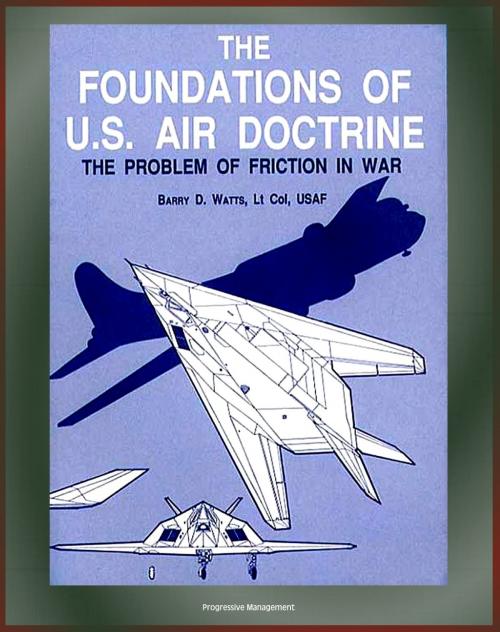The Foundations of U.S. Air Doctrine: The Problem of Friction in War - Airpower Strategy, World War II Bomber Offensive Plan, Korea, Douhet, Billy Mitchell, Clausewitzian Doctrine
Nonfiction, History, Military, Nuclear Warfare, Aviation| Author: | Progressive Management | ISBN: | 9781476493046 |
| Publisher: | Progressive Management | Publication: | June 6, 2012 |
| Imprint: | Smashwords Edition | Language: | English |
| Author: | Progressive Management |
| ISBN: | 9781476493046 |
| Publisher: | Progressive Management |
| Publication: | June 6, 2012 |
| Imprint: | Smashwords Edition |
| Language: | English |
This study revolves around friction, meaning the ubiquitous uncertainties and inescapable difficulties that form the atmosphere of real war. More specifically, it attempts to utilize the Clausewitzian concept of general friction as a basis for assessing — and, if necessary, reshaping — the foundations of US air doctrine. This critical application of friction gives rise to four primary conclusions: (1) The key assumptions underlying mainstream US doctrine for conventional air warfare have not evolved appreciably since Air Corps Tactical School (ACTS) theorists elaborated their theory of precision, industrial bombardment during the 1930s. (2) Judged by their essential premises and logic, post-Hiroshima theories of deterrence are little more than an updating for the nuclear age of ACTS bombardment doctrine. (3) Both ACTS bombardment doctrine and deterrence theory appear fundamentally flawed insofar as they omit the frictional considerations that distinguish real war from war on paper. (4) Reflection upon the extent to which friction pervades the elemental processes of actual combat suggests that the range of situations in which greater numbers or superior weapons guarantee victory is relatively limited; even in the age of thermonuclear weapons, the outcomes of battles still turn, more often than not, on the character and intelligence of a few brave individuals. The first step in giving substance to these claims is to explain what the central beliefs of US airmen traditionally have been. The reader should be warned, however, that I have approached the writings on war of airmen like Major General Haywood S. Hansell, Jr., and nuclear strategists like Bernard Brodie—as well as those of Carl von Clausewitz himself—from the perspective of two interrelated questions. What overriding assumptions about war did these individuals embrace? And what image of war as a total phenomenon is bound up in their assumptions? In large part, answering these questions is a matter of historical inquiry and, to be candid, I have been far less concerned with writing history for its own sake than with using the past to illuminate the problems of the present. I, therefore, leave it to the reader to judge whether I have managed to do so without injuring the historical record.
Contents: 1 INTRODUCTION * Notes * 2 DOUHET AND MITCHELL * Douhet's Image of War: Unrestrained Offense * Mitchell's "Aerial Knights" * Notes * 3 THE FIRST US STRATEGIC AIR WAR PLAN * Daylight, High Altitude, Precision Bombardment * Doctrine * AWPD-1 * The Image of War in AWPD-1 * Notes * 4 THE POLICY AND STRATEGY OF DETERRENCE * Brodie's Assumptions * Brodie's Image of All-Out War in the Missile Age * A Paradox of Deterrence Theory * Notes * 5 A CLAUSEWITZIAN CRITIQUE * The Core Beliefs of Mainstream US Air Doctrine * Some Ramifications * Friction * Collective Risk * Notes * 6 FRICTION IN 20TH CENTURY WARFARE * Part 1: Friction in the Combined Bomber Offensive, World War II * Weather * October 1943: Information, Doctrinal Rigidity, Enemy Countermeasures * Big Week and the Problem of Industrial Impact Assessments * March and April 1944: Friction as a Weapon * Epilogue in Korea: Railway Interdiction, August 1951-May 1952 * Part 2: Friction in the Missile Age * The Not-So-Delicate Balance of Terror * The Emergence of Friction in Brodie's Thought * The Cuban Missile Crisis * Notes * 7 TOWARD A LESS MECHANISTIC IMAGE OF WAR * US Air Doctrine and Laplacian Determinism * Cartesian Hypotheses, Uncertainty, Undecidability * The Human Cost of War * Combat Psychology as Context * Some Consequences of Embracing a More Organic Image of War * Learning from History * Nurturing Military Genius * Exemplars for Future Wars: Friction as a Weapon and Entropy * Summing Up * Notes * APPENDIX * General Eaker's Presentation of the Combined Bomber Offensive Plan to the Joint Chiefs of Staff * SELECTED BIBLIOGRAPHY
This study revolves around friction, meaning the ubiquitous uncertainties and inescapable difficulties that form the atmosphere of real war. More specifically, it attempts to utilize the Clausewitzian concept of general friction as a basis for assessing — and, if necessary, reshaping — the foundations of US air doctrine. This critical application of friction gives rise to four primary conclusions: (1) The key assumptions underlying mainstream US doctrine for conventional air warfare have not evolved appreciably since Air Corps Tactical School (ACTS) theorists elaborated their theory of precision, industrial bombardment during the 1930s. (2) Judged by their essential premises and logic, post-Hiroshima theories of deterrence are little more than an updating for the nuclear age of ACTS bombardment doctrine. (3) Both ACTS bombardment doctrine and deterrence theory appear fundamentally flawed insofar as they omit the frictional considerations that distinguish real war from war on paper. (4) Reflection upon the extent to which friction pervades the elemental processes of actual combat suggests that the range of situations in which greater numbers or superior weapons guarantee victory is relatively limited; even in the age of thermonuclear weapons, the outcomes of battles still turn, more often than not, on the character and intelligence of a few brave individuals. The first step in giving substance to these claims is to explain what the central beliefs of US airmen traditionally have been. The reader should be warned, however, that I have approached the writings on war of airmen like Major General Haywood S. Hansell, Jr., and nuclear strategists like Bernard Brodie—as well as those of Carl von Clausewitz himself—from the perspective of two interrelated questions. What overriding assumptions about war did these individuals embrace? And what image of war as a total phenomenon is bound up in their assumptions? In large part, answering these questions is a matter of historical inquiry and, to be candid, I have been far less concerned with writing history for its own sake than with using the past to illuminate the problems of the present. I, therefore, leave it to the reader to judge whether I have managed to do so without injuring the historical record.
Contents: 1 INTRODUCTION * Notes * 2 DOUHET AND MITCHELL * Douhet's Image of War: Unrestrained Offense * Mitchell's "Aerial Knights" * Notes * 3 THE FIRST US STRATEGIC AIR WAR PLAN * Daylight, High Altitude, Precision Bombardment * Doctrine * AWPD-1 * The Image of War in AWPD-1 * Notes * 4 THE POLICY AND STRATEGY OF DETERRENCE * Brodie's Assumptions * Brodie's Image of All-Out War in the Missile Age * A Paradox of Deterrence Theory * Notes * 5 A CLAUSEWITZIAN CRITIQUE * The Core Beliefs of Mainstream US Air Doctrine * Some Ramifications * Friction * Collective Risk * Notes * 6 FRICTION IN 20TH CENTURY WARFARE * Part 1: Friction in the Combined Bomber Offensive, World War II * Weather * October 1943: Information, Doctrinal Rigidity, Enemy Countermeasures * Big Week and the Problem of Industrial Impact Assessments * March and April 1944: Friction as a Weapon * Epilogue in Korea: Railway Interdiction, August 1951-May 1952 * Part 2: Friction in the Missile Age * The Not-So-Delicate Balance of Terror * The Emergence of Friction in Brodie's Thought * The Cuban Missile Crisis * Notes * 7 TOWARD A LESS MECHANISTIC IMAGE OF WAR * US Air Doctrine and Laplacian Determinism * Cartesian Hypotheses, Uncertainty, Undecidability * The Human Cost of War * Combat Psychology as Context * Some Consequences of Embracing a More Organic Image of War * Learning from History * Nurturing Military Genius * Exemplars for Future Wars: Friction as a Weapon and Entropy * Summing Up * Notes * APPENDIX * General Eaker's Presentation of the Combined Bomber Offensive Plan to the Joint Chiefs of Staff * SELECTED BIBLIOGRAPHY















